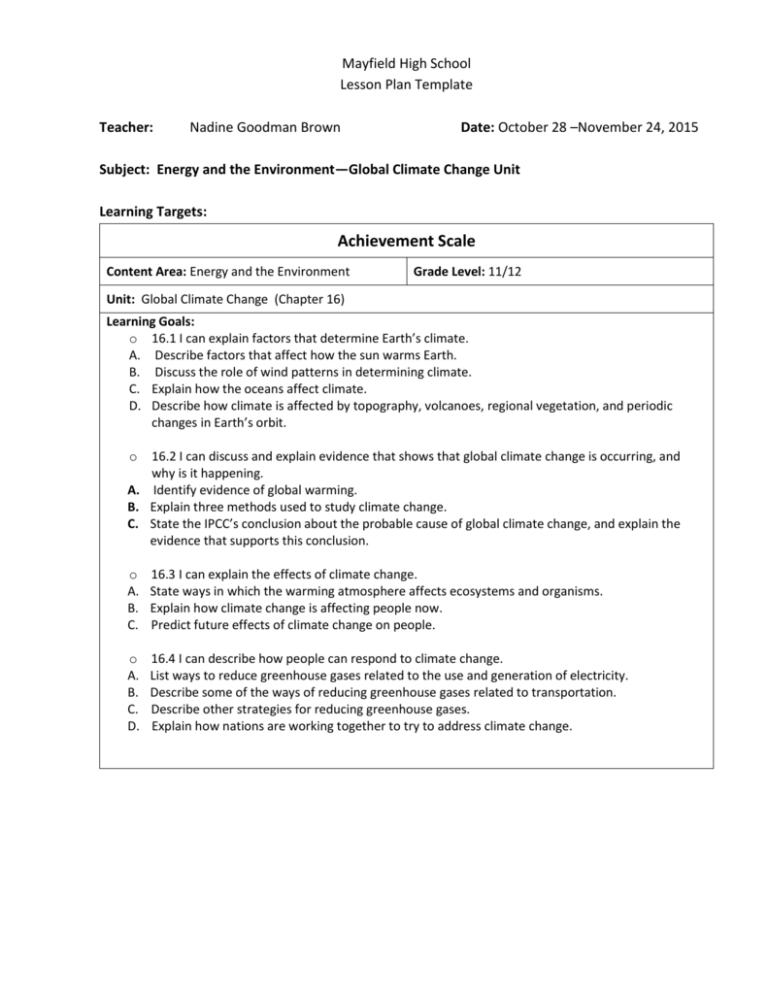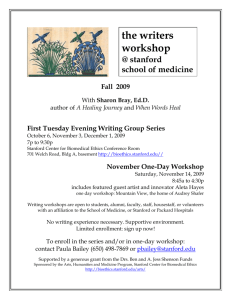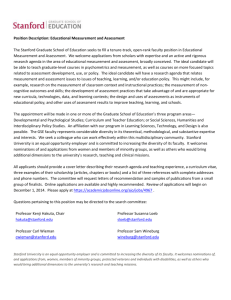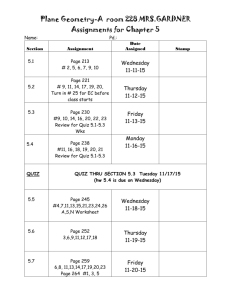climate change lesson plan
advertisement

Mayfield High School Lesson Plan Template Teacher: Nadine Goodman Brown Date: October 28 –November 24, 2015 Subject: Energy and the Environment—Global Climate Change Unit Learning Targets: Achievement Scale Content Area: Energy and the Environment Grade Level: 11/12 Unit: Global Climate Change (Chapter 16) Learning Goals: o 16.1 I can explain factors that determine Earth’s climate. A. Describe factors that affect how the sun warms Earth. B. Discuss the role of wind patterns in determining climate. C. Explain how the oceans affect climate. D. Describe how climate is affected by topography, volcanoes, regional vegetation, and periodic changes in Earth’s orbit. o 16.2 I can discuss and explain evidence that shows that global climate change is occurring, and why is it happening. A. Identify evidence of global warming. B. Explain three methods used to study climate change. C. State the IPCC’s conclusion about the probable cause of global climate change, and explain the evidence that supports this conclusion. o A. B. C. 16.3 I can explain the effects of climate change. State ways in which the warming atmosphere affects ecosystems and organisms. Explain how climate change is affecting people now. Predict future effects of climate change on people. o A. B. C. D. 16.4 I can describe how people can respond to climate change. List ways to reduce greenhouse gases related to the use and generation of electricity. Describe some of the ways of reducing greenhouse gases related to transportation. Describe other strategies for reducing greenhouse gases. Explain how nations are working together to try to address climate change. Score 3: Student demonstrates no major errors or omissions regarding the learning goal(s) that were explicitly taught: 16.1A Explain the difference between the warming of the earth by the sun during the seasons for temperate regions in the Northern versus Southern hemisphere. 16.1B Diagram how wind patterns are related to whether winds are located over the tropics versus over the temperate regions or polar regions of the earth. Explain the role of winds in the drier climates of mid-continent grasslands versus the more moist climates of coastal regions of temperate regions. 16.1C Discuss the importance of differential ocean temperatures at the equator versus N and S latitudes, relative to determining the location of different climate regions. 16.1D After watching the BBC Documentary, “Are we changing the climate,” identify and discuss at least one specific example of how the earth’s climate can change as a result of changes in: Topography, Volcanoes, Regional vegetation, and Periodic changes in Earth’s orbit. 16.2 A Analyze diagrams of atmospheric CO2 versus global average temperature data to explain evidence of global warming. Also, analyze ice core CO2 and calculated temperatures data, as well as sediment calculated temperature data, to explain evidence of global warming. 16.2 B Describe and explain these methods for studying climate change: 1) ice core analysis, 2) computer modelling, 3) tree ring analysis, 4) sediment analysis, and 5) atmospheric analysis. 16.2 C Given a reading that presents an individual’s or organization’s stance on whether human-induced climate change is occurring, cite evidence from within the reading to describe how the stance is in agreement or in contrast to the IPCC’s statement on climate change. 16.3 A Given graphs and data tables that describe ranges, migration patterns, health trends, or food finding behaviors of organisms in previous decades versus recent decades, explain how warming has likely been the cause of these changes. 16.3 A Discuss four specific, different ways in which increasing CO2 concentrations and temperatures of oceans has been harmful either to marine life or other species, including humans. 16.3 B Discuss ways that climate change has been economically beneficial for some people, but economically harmful for others; also, explain why changing climate can negatively impact human health. 16.3 C After reading the lesson and after watching National Geographic’s documentary, “Six degrees can change the world”, distinguish between the likely negative future impacts of climate change on humans as a result of immediate versus delayed compliance with recommendations being made by the climate scientists. Score 2: The student demonstrates no major errors or omissions regarding the simpler details and processes that support the learning goal(s). 16.1-16.4 Define vocabulary terms or identify examples or descriptions of these terms. 16.1 Identify the greenhouse gases and state the relationship between greenhouse gas concentrations and temperature. 16.1 Identify the latitude ranges for the tropical, temperature, and polar climate zones. 16.2 Provide 5 different classes of evidence in support of ongoing climate change. 16.2 Identify 3 methods for studying earth’s past climate, as well as one method for making predictions about the earth’s future climate. 16.3 List three negative impacts that humans are currently experiencing as a result of global warming. 16.4 The student can identify sources of electricity that have lower greenhouse gas emissions than fossil fuel powered electricity generation. 16.5 The student can identify three general strategies for reducing transportation-related greenhouse emissions. Score 1: With help (being given word banks, manipulated equations, retakes), the student demonstrates a partial understanding of the simpler details and processes that support the learning goal(s). Score 0: Even with help, no success Academic Vocabulary: 16.1 greenhouse effect, greenhouse gas, thermohaline circulation, El Niño, topography 16.2 IPCC, global climate change, global warming, proxy indicator, climate model, fossil fuel 16.3 coral bleaching 16.4 carbon footprint, carbon tax, carbon offset, carbon sequestration, Kyoto Protocol Strategies/Activities: Day 1 Tuesday, 10/27 Poll—current stance on the importance of climate change. Two short readings, one taking stance that US should not act on climate change vs other that climate change is most important concern for US; answer questions discuss stances/cited evidence. homework: poll family and friends on topic and be prepared to report Day 2-Day 3 Wednesday, 10/28—Thursday, 10/29 Discuss polling results Watch BBC documentary, “Are we causing climate change?”. Stop after each main set of ideas to discuss and answer questions. Homework: Begin reading and Stanford notes for chapter 16, lesson 1 (controllers of climate) Day 4 Friday, 10/30 Concept mapping for ideas in documentary, then completion of a corresponding outline. (huge concept maps made to allow for partners to complete them) Day 5 Monday, 11/2 Formative assessment using questions directly discussed in movie & reviewed in concept map Go over answers, intervention as needed Homework—complete notes for ch 16 lesson 1 Day 6 Tuesday, 11/3 Quiz, BBC movie concepts (what controls the climate & causes changes in climate—methods for studying the climate & its history/future) Go over quiz Lesson—students improve Stanford notes while teacher uses the textbook chapter to present the lesson (topics in chapter 16 lesson 1 are the same as those presented in the BBC documentary) Homework—review Stanford notes and class notes, complete study guide chapter 16, lesson 1 Day 7 Wednesday, 11/4 Vocab review via crossword, allow students who have completed study guides to check answers Lab—factors affecting the average weather conditions in the 6 climate zones—focus: relative speed of rotation (and atmosphere) at different latitudes (determine diameter and relative speed at latitudes defining tropical, temperate, and polar zones, as well as the equator) Homework—prepare for open note quiz on 16.1—factors that control/change climate—on day 9 Day 8 Thursday, 11/5 Concept mapping—chapter 16 lesson 1 Animation online—the reason for the seasons, complete diagram & questions Lab—intensity of sunlight at start of each season at equator vs northern and southern hemispheres Lab—convection of liquids Homework-quiz 16.1, lab concepts tomorrow—may want to review BBC documentary questions, too, since these cover the same learning goals and vocabulary Day 9 Friday, 11/6 Open note quiz—causes for variation in climate (same as for the BBC documentary) Homework—stanford notes and study guide for chapter 16, lesson 2 due before Wednesday, 11/11 Day 10 Monday, 11/9 Overview of chapter 16-lesson 2 (read end of chapter summary, teacher generated concept map) Topics—Evidence for and causes of global climate change Students given time to work on chapter 16, lesson 2, Stanford notes & study guide Homework: complete 16, lesson 2, Stanford notes and study guide prior to day 11/11 Day 11 Tuesday, 11/10 Lesson on chapter 16 lesson 2 using text, with students following along in Stanford notes, making improvements as needed; revisit concept maps; vocabulary review via matching & crossword Graph analysis: real data activity from the text 16.2 & emissions graphs from last two pages of 16.2—discuss the meaning of the data, be ready to present on some aspect of the graphs when called upon Homework: be ready for open note quiz, 16.2, tomorrow Day 12 Wednesday, 11/11 Open Stanford note and study guide and class note quiz, 16.2 Afterwards, begin work on 16.3 stanford notes and study guide Homework: Stanford notes and study guide for 16.3 to be used in an open note quiz on day 16 Day 13 Thursday, 11/12 Revisit most common mistakes on yesterday’s quiz Lesson overview—impacts of climate change—read summary, concept map 16.3 Vocabulary introduction—preparation for movie Movie—part 1 (questions 1-11: topics evidence that climate change is occurring and that human use of fossil fuels for energy is driving climate change)—National geographic 2009, “Six degrees could change the world”; after each major section, students will discuss section, then answer questions. These are the same topics as covered in chapter 16.3 Homework— Stanford notes and study guide for 16.3 to be used in an open note quiz on day 17 Day 14 Friday, 11/13 Review movie scenes from day 13, show section 2 (questions 12—22: impacts that became evident when average global temperatures had risen more than 1 °F…we’ve increased by 1.4 °F) Movie part 2 Homework— Stanford notes and study guide for 16.3 to be used in an open note quiz on day 17 Day 15 Monday, 11/16 Review movie scenes from day 14, Show movie section 3 (questions 23-24—impact of warming on forests & forests on rest of world) Movie part 3 Homework: Stanford notes and study guide for 16.3 to be used in an open note quiz on day 18 Day 16 Tuesday, 11/17 Show movie section 4 (questions 25-30—impacts of warming either 3 or 4 degrees F above late 1800’s global averages)—don’t show end of movie yet, as this is the topic for chapter 16.4 (solutions to climate change) Movie part 4 Provide any remaining time for students to work on Stanford notes and study guides for lesson 16.3. Homework: review movie notes, Stanford notes, study guides for open note quiz on day 18 Day 17 Wednesday, 11/18 Lesson from ch 16.3 while students follow along in notes Allow students who have completed movie notes and study guides to check answers Opening reading—case study—flooding of Maldive islands—read/discuss/answer questions Homework: open note quiz tomorrow, day 18, on chapter 16.3 (you can use class notes, too, but only your own original copies) Day 18 Thursday, 11/19 Open note quiz Time left and homework: work on 16.4 stanford notes and study guide Homework: 16.4 stanford notes, 16.4 study guide, rest of movie notes & 16.4 class notes will be available for use—own original copies, only—on open note quiz on Tuesday, 11/24 Day 19 Friday, 11/20 Lesson—ways to slow carbon dioxide emission rates & to reduce warming (topic, chapter 16.4), students follow along with handout and with stanford notes for 16.4 Finish video “six degrees could change the world” (how to reduce warming), do questions 31-38 Link lesson to movie Homework—work on 16.4 stanford notes and study guide Day 19 Monday, 11/23 Wrap up into ways to reduce warming. Make concept map. Read “skeptic article: consensus on climate change and discuss. Homework: chapter 16.4 open note quiz tomorrow. Day 20 Tuesday, 11/24 Open note quiz on 16.4 Introduce projects Homework—decide upon project topic Days 21-25 Day 26, 27 11/30-12/4Project work and feedback 12/7-12/8 Poster session—share with colleagues Materials: Assessment(s):






